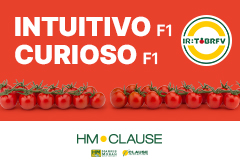Horticultores El Torcal is backing a sustained growth of asparagus, limiting the surface area per farmer to prevent the market from collapsing.
The so-called ‘green gold’ has been increasing in importance in the cooperative from Antequera until reaching the same level in terms of turnover as its star crop, the potato (onions have dropped to third place). This increase, caused by the profitability of the produce and the increase in demand, has gone hand in hand with the incorporation of new farmers, 10 more during this campaign, making a total of 60, as well as the amount of asparagus crop land: 50 hectares more this year (and they already have 200 in production). However, this positive evolution involves certain risks such as a saturation of the offer. And the fact is that, as the manager, Juan Antonio Romero explains, “some limits must be established in terms of the demand in order to continue obtaining reasonable prices. The expenses are very high, particularly for labour and if they are not covered, people will stop sowing the crop and we will all lose out”. Therefore, at El Torcal they have chosen to limit the surface area to a maximum of 10-15 hectares per producer to encourage the distribution of the crop and ensure that it retains the social, employment and wealth generating nature for the region that has traditionally characterised it.
“After this campaign, an analysis should be made to regulate the sector. The immense majority of Andalusian production is channelled through cooperatives, and the Federation of Cooperatives should take control to plan the crops according to the real needs of the demand”.
For this year, where the surface area and the yield per hectare (+40%) have increased, an increase in production of around 50% at El Torcal is predicted, making a total of between 1 and 1.2 million kilos. “The conditions have been suitable, with enough rainfall in December and January and low temperatures during the winter halt”, he explains. Therefore, he forecasts that “prices are not going to be as good as in other years”.
The cooperative exports 90% of its asparagus, with France and Germany as the main destinations, followed by others such as Italy, the United Kingdom and Switzerland… The latter is a destination that is “very demanding and that values the produce very highly, but that is paying less for asparagus this year because the discount is increasing and this affects the prices”.
























